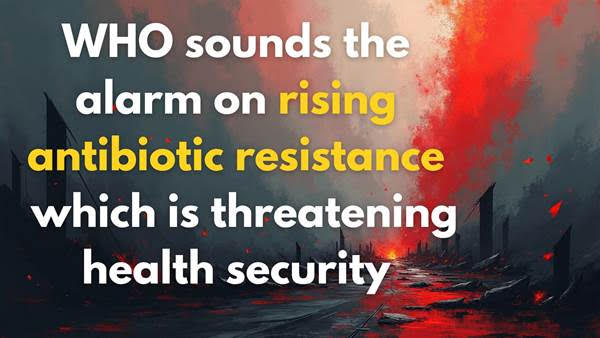WHO Sounds Alarm Over Rising Antibiotic Resistance Threatening Global Health Security
The world is rapidly approaching a crisis of widespread resistance to common antibiotics. The World Health Organization (WHO), launched its Global Antibiotic Resistance Surveillance Report 2025, warning that escalating resistance to essential antibiotics poses a serious threat to public health systems worldwide—particularly in countries least equipped to respond.
Data from 104 countries submitted to the WHO’s Global Antimicrobial Resistance and Use Surveillance System (GLASS) indicate that between 2018 and 2023, bacterial resistance to 40% of monitored antibiotics increased by 5–15% annually. Analysing over 23 million confirmed infections, the report estimates that one in six common bacterial infections globally were resistant to antibiotics in 2023.
The report examines resistance to 22 critical antibiotics used to treat urinary tract, gastrointestinal, and bloodstream infections, as well as gonorrhoea. As first-line treatments lose effectiveness, clinicians are increasingly forced to rely on intravenous therapy and “last-resort” antibiotics—often costly, scarce, or unavailable in low- and middle-income countries.
Antibiotic resistance is unevenly distributed across the globe:
- Southeast Asia and the Eastern Mediterranean: 33% of infections resistant.
- African Region: 1 in 5 infections resistant.
- Europe: 1 in 10 infections resistant.
- Western Pacific: 1 in 11 infections resistant.
These variations reflect differences in healthcare systems, surveillance capacity, and access to medicines.
WHO highlights gram-negative bacteria as the most concerning. E. coli and Klebsiella pneumoniae are now the leading drug-resistant pathogens in bloodstream infections, often causing sepsis, organ failure, and death.
- Over 40% of E. coli and 55% of K. pneumoniae strains are resistant to third-generation cephalosporins.
- In the African Region, resistance exceeds 70% for both pathogens.
Other pathogens, including Salmonella, Acinetobacter, and N. gonorrhoeae, are increasingly resistant to carbapenems and fluoroquinolones, further limiting treatment options.
- Cephalosporin-resistant E. coli: 45% global bloodstream resistance; highest in Africa at 71%.
- Carbapenem-resistant K. pneumoniae: 17% bloodstream, 11% urinary tract globally; highest in Southeast Asia (41% bloodstream).
- MRSA: 27% global bloodstream resistance; Eastern Mediterranean highest at 50%.
- Fluoroquinolone-resistant Salmonella spp.: 18% bloodstream, 16% GI globally; Europe highest at 36% bloodstream.
- Drug-resistant N. gonorrhoeae: 75% global ciprofloxacin resistance; 88% in Southeast Asia.
Since GLASS was established in 2016, participation has risen from 25 to 104 countries by 2023, demonstrating growing global commitment. Yet, gaps remain:
- 48% of countries did not submit any data in 2023.
- Nearly half of reporting countries lack robust data systems.
- Surveillance coverage is lowest in Southeast Asia and Africa, despite high participation, and highest in Europe and the Western Pacific.
Dr Silvia Bertagnolio, WHO’s Unit Head for Surveillance, notes: “Antibiotic resistance disproportionately affects low- and middle-income countries with weaker health systems. Those facing the greatest burden often have the least capacity to monitor resistance. Without strong surveillance, resistance spreads unchecked.”
She adds that resistance data may also be skewed in countries with poor surveillance, due to overrepresentation of tertiary hospitals where severe cases concentrate.
Dr Yvan Hutin, Director of WHO’s AMR Division, emphasises that prevention is the most effective strategy:”If infections do not occur, resistance cannot develop. Prioritising water, sanitation, hygiene (WASH), and vaccination is essential.”
He advocates for broader access to existing vaccines, development of new ones, and investment in public health infrastructure to prevent infections. Dr Hutin also stresses public awareness: “Not every fever requires an antibiotic. A doctor’s refusal often reflects correct clinical judgment when the infection is viral.”
Antimicrobial resistance (AMR) already claims millions of lives: in 2021, bacterial infections caused an estimated 7.7 million deaths, with 4.71 million linked to AMR and 1.14 million directly attributed to resistant infections.
Excessive or inappropriate use of antibiotics, antivirals, antifungals, and antiparasitics could accelerate the crisis. Access must be balanced with stewardship: overuse today risks no cure tomorrow.
The 2024 United Nations High-Level Meeting on AMR political declaration urges countries to:
- Strengthen health systems and surveillance
- Invest in infection prevention and control
- Expand vaccination, diagnostics, and lab capacity
- Optimise treatment protocols and preserve existing antimicrobials
- Adopt a One Health approach linking human, animal, and environmental health
AMR is not a looming threat—it is already a global health emergency. Without urgent, coordinated action, minor infections could once again become deadly. Protecting antimicrobial medicines through careful use, robust surveillance, and prevention is vital.



